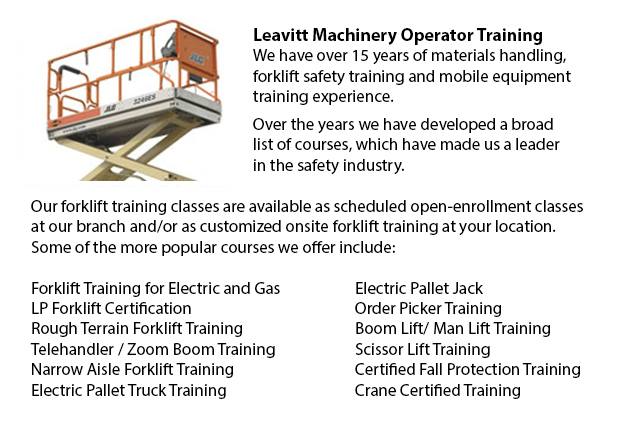
Scissor Lift Certification Markham - Many worksites and tradespeople like for example masons, iron workers and welders use scissor lift platforms in order to help them reach elevated work areas. The operation of a scissor lift is often secondary to their trade. Thus, it is vital that all platform operators be trained properly and certified. Lift manufacturers, regulators and industry work together in order to ensure that operators are trained in the safe utilization of work platforms.
Work platforms are likewise called manlifts or AWPs. These equipment are stable and easy to utilize, even though there is always some risk because they lift individuals to heights. The following are various key safety issues common to AWPs:
There is a minimum safe approach distance (likewise known as MSAD) for all platforms so as to protect from accidental power discharge due to proximity to power lines and wires. Voltage can arc across the air and cause injury to workers on a work platform if MSAD is not observed.
Care should be taken when the work platform is lowered to guarantee steadiness. The boom should be retracted, moving the load toward the turntable. This will help maintain steadiness in lowering of the platform.
Regulations do not mandate individuals working on a scissor lift to tie off. However, workers might be required to tie off if needed by employer guidelines, job-specific risk assessments or local regulations. The manufacturer-provided anchorage is the only safe anchorage to which lanyard and harness combinations should be attached.
It is essential to observe and not go over the maximum slope rating. The grade could be measured by laying a straight edge on the slope or by laying a board. A carpenter's level can then be placed on the straight edge and raised until the end is level. By measuring the distance to the ground and dividing the rise by the straight edge's length, then multiplying by 100, the per cent slope can be determined.
A typical walk-around inspection should be done to determine if the unit is mechanically safe. A site assessment determines if the work area is safe. This is important especially on changing construction locations because of the risk of obstacles, contact with power lines and unimproved surfaces. A function test has to be performed. If the unit is utilized safely and properly and right shutdown procedures are followed, the chances of incident are greatly lessened.
-
Crane / Overhead Crane / Self-Erect Crane / Truck Mounted Crane / Hydraulic Cranes Training in Markham
Bridge cranes or overhead cranes are a kind of industrial material handling crane making use of a hook and line apparatus that runs on a horizontal beam running along two widely separated rails. Many overhead cranes could be seen inside a long factor... More -
Manlift Ticket Markham
Manlift Ticket Markham - The Manlifts and Elevated Platforms program provides training on the regulations, rules and correct application of safe operating procedures and work practices involved in everyday activities for individuals who work with thi... More -
Aerial Lift Train the Trainer Markham
Aerial Lift Train the Trainer Markham - The Aerial Lifts Train the Trainer Certification Program will teach trainers how to effectively train operators in safe industrial mobile equipment operation. Trainers are given in-depth instruction on aerial l... More -
Loader Operator Training Markham
Loader Operator Training Markham - Loader Operator Training - Within North America, lift truck operator training is required to be able to prevent workplace injuries and accidents. Certain forklift training would be provided to be able to offer forkl... More -
Aerial Boom Lift Ticket Markham
Aerial Boom Lift Ticket Markham - Aerial lift trucks can be used to accomplish many unique duties done in hard to reach aerial spaces. A few of the duties associated with this style of jack include performing daily repair on buildings with high ceili... More -
Boom Lift Operator Training Markham
Boom Lift Operator Training Markham - The cherry picker work platform is a type of work platform, that will usually have a bucket or platform at the hydraulic lifting system's end. The machine is likewise called a boom lift, man lift, hydraladder or... More -
Boom Lift License Markham
Boom Lift License Markham - Just fully qualified individuals must operate an aerial boom lift. Qualification can be obtained through a combination of classroom sessions and practical training with the particular kind of aerial lift that will be used... More -
Telehandler Training Courses Markham
Telehandler Training Courses Markham - The employer has the responsibility to make certain that their workers are trained to work proficiently with telehandler machines. The staff have to be assessed for their skill to utilize the equipment. If defic... More

Forklift Training Markham
TOLL FREE: 1-888-254-6157
Markham, Ontario
forklifttrainingmarkham.com
Email Us
About Us


